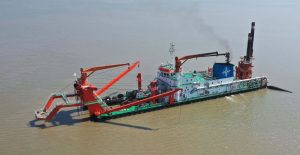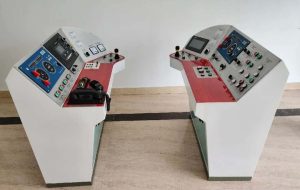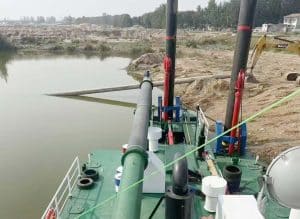Key Takeaways: Dismountable Dredger Transport at a Glance
| Transport Method | Best For | Key Advantage | Typical Dredger Size |
|---|---|---|---|
| Road Transport | Short to medium distances, accessible sites | Flexibility and direct delivery | Small to medium (CSD250-350) |
| Rail Transport | Long inland distances, remote locations | Cost-effective for large volumes | Small to large (component dependent) |
| Sea Transport | Overseas projects, coastal sites | Global deployment capability | Medium to large (CSD500-600+) |
| Waterway Towing | Final positioning, nearby relocations | No disassembly required | All sizes (assembled units) |
Dismountable cutter suction dredgers unlock access to remote sites through their intelligent modular design. Their segmented components can be shipped worldwide via standard transport methods, then quickly reassembled on-site for immediate dredging operations.
Understanding Dismountable Cutter Suction Dredgers
Ever wonder how massive dredging equipment reaches remote inland lakes or construction sites miles from navigable waters?
The answer: dismountable cutter suction dredgers.
Unlike traditional dredgers permanently built as single units, dismountable models break down into transportable modules. This game-changing design makes previously inaccessible locations completely workable.
Think of them as industrial-grade puzzle pieces. Each component—pontoons, main hull, ladder, pumps—separates for transport then reconnects at the worksite.
Modern dredging projects increasingly demand equipment that can:
- Reach landlocked water bodies
- Navigate under low bridges or through narrow passages
- Deploy to remote mining operations
- Service small harbors and shallow coastal areas
Dismountable designs meet these challenges head-on. They enable dredgers to go wherever standard shipping containers can go—virtually anywhere on the planet.
Let’s dive deeper into the engineering that makes this possible.
The Engineering Behind Transportable Dredger Design
The magic of dismountable dredgers isn’t just that they come apart—it’s how they’re designed to break down and reassemble with precision.
Segmented Hull Structure: The Foundation of Mobility
At their core, transportable dredgers feature a segmented hull typically consisting of:
- Main hull section – Contains the primary machinery, pump systems, and operator controls
- Four modular pontoons – Provide stability and flotation when attached
This smart design keeps the main hull narrow enough for standard road transport when pontoons are detached. More importantly, the machinery shed height can be lowered when the control room is removed, making it compliant with highway and railway clearance requirements.
“The segmented design allows dredging operations in non-navigable rivers, reservoirs, and ponds that would otherwise require prohibitively expensive specialized equipment mobilization.” – International Dredging Review
Component Size and Weight Engineering
Engineers obsess over two critical factors when designing dismountable dredgers:
- Maximum component dimensions must stay within road and container transport limits
- Individual weights must remain manageable for standard cranes and handling equipment
This balancing act requires intense optimization. For example, a 500mm dredger pump might be split into sections rather than transported as one massive unit. Hydraulic systems might use quick-connect fittings to minimize fluid drainage during transport.
The result? Complex industrial equipment that travels like standard freight.
The Innovative Connecting Hook System
Perhaps the most clever engineering feature is the unique connection system between hull sections. Modern dismountable dredgers employ a sophisticated hook mechanism that:
- Secures pontoons to the main hull through connecting plates with bolts at deck level
- Uses special connecting hooks at the bottom for underwater stability
- Creates a watertight seal below the waterline
- Maintains full hull strength during operation
During disassembly, workers partially fill pontoons with water to disengage the connecting hooks after loosening the deck-level bolts. For assembly, they reverse the process—position the pontoons, secure the upper connections, then pump out the water to engage the hooks.
This ingenious system eliminates the structural weakness found in designs that only connect at the top, which often suffer from connecting plate fractures or beam deformation during operation.
With these engineering foundations understood, let’s explore exactly how these modular giants move across land and sea.
Primary Transport Methods for Dismountable Dredgers
Moving dismountable dredgers isn’t a one-size-fits-all process. Different projects and locations demand different transport approaches. Here’s how these specialized vessels make their way around the globe:
Road Transport: Trucks and Containerization
Road transport offers the most direct delivery method for dismountable dredgers, especially smaller models like the CSD250 or CSD350.
The process typically works like this:
- Components are loaded onto flatbed trucks or into open-top 40-foot containers
- Oversized components receive special permits and escort vehicles
- Smaller components travel as standard freight
- Multiple trucks transport the complete dredger system
For perspective, a complete CSD250 dredger typically requires just three trucks for transport—making it remarkably mobile compared to traditional dredging equipment.
The container-friendly design also simplifies customs clearance for international shipments, as components can travel through standard shipping channels.
Rail Transport: Reaching Deep Inland
For projects in remote inland locations, rail transport offers compelling advantages:
- More cost-effective than road transport for long distances
- Higher weight capacity for larger components
- Access to regions with limited road infrastructure
- Reduced transport-related emissions per ton-mile
Dredger components are specifically designed with rail loading gauge restrictions in mind. The main hull width and superstructure height are engineered to comply with standard rail clearance profiles when pontoons and the control room are removed.
This makes rail transport viable even for larger dredgers like the 500-600mm class models, which might otherwise require prohibitively expensive specialized road transport.
Sea Transport: Global Deployment
For overseas projects, dismountable dredgers typically travel as deck cargo on:
- Heavy lift vessels for larger components
- Standard container ships for containerized modules
- Roll-on/roll-off vessels for wheeled components
The modular design allows for creative loading arrangements that maximize space efficiency. For example, a dredger’s ladder can nest inside pontoon sections, or multiple small dredgers might ship alongside other construction equipment.
Once a dismountable dredger reaches its destination port, it typically transfers to one of the land-based transport methods for final delivery to the project site.
Waterway Transport: Final Positioning
Sometimes, dismountable dredgers can be partially assembled at a nearby port or assembly point, then towed to the final site. This approach:
- Reduces total assembly time at the remote location
- Minimizes the need for heavy lifting equipment at difficult sites
- Allows for more efficient workforce utilization
For short relocations between nearby worksites, fully assembled dredgers with onboard propulsion can sometimes travel under their own power, eliminating the need for disassembly altogether.
Now that we understand how these machines travel, let’s examine what happens when they reach their destination.
Assembly Process at the Dredging Site
When a dismountable dredger reaches its destination, a carefully orchestrated assembly process begins. Here’s how these industrial puzzles come together:
Step-by-Step Assembly Procedure
The typical assembly sequence follows these critical steps:
- Site preparation – Ensuring adequate water depth and shore support
- Main hull positioning – Placing the central section near the shoreline
- Pontoon attachment – Using the connecting hook system to join flotation sections
- Ladder installation – Mounting the cutting apparatus and dredging arm
- Spud pole positioning – Installing the anchoring/positioning poles
- Electrical and hydraulic connections – Completing all system hookups
- Control room mounting – Installing the operator station
- Testing and commissioning – Verifying all systems before operation
Depending on the dredger size and site conditions, this process typically takes between 3-14 days with a skilled assembly team.
“Plug and Play” Modular Systems
Modern dismountable dredgers increasingly use “plug and play” design philosophy to speed assembly:
- Pre-assembled hydraulic power packs ship as complete units
- Electrical systems use standardized quick-connect interfaces
- Control systems feature pre-programmed automation
- Dredge pump modules include pre-mounted drives and bearings
These pre-engineered subsystems dramatically reduce assembly time and minimize the chance of errors during field setup.
“Today’s skid-mounted hydraulic and mechanical modules arrive ready to install, reducing on-site assembly time by up to 60% compared to older designs.” – Dredging Engineering Journal
Post-Assembly Mobilization
After assembly, most dismountable dredgers can position themselves using:
- Onboard propulsion systems for self-propelled models
- Spud walking mechanisms that “step” the dredger forward
- Cable positioning systems for precise movement control
This self-mobilization capability enables the dredger to reach its exact working position without additional external equipment—a crucial advantage at remote sites where support vessels might be unavailable.
With the assembly process complete, these engineering marvels are ready to tackle projects that would be inaccessible to conventional dredging equipment.
Real-World Applications and Case Studies
Dismountable dredgers solve unique problems across diverse environments. Let’s explore where these versatile machines make the biggest impact:
Inland Waterway Projects
Inland waterways present unique challenges for dredging operations:
- Limited access for conventional equipment
- Navigation restrictions (bridges, locks, shallow areas)
- Remote locations far from maritime infrastructure
Dismountable dredgers excel in these environments. For example, a mining company in central Africa recently transported a 450mm dismountable dredger over 800 miles inland to maintain a tailings reservoir. The journey involved:
- Ocean shipping to the nearest port
- Rail transport for 600 miles
- Final road delivery to the mountain mining site
Without its dismountable design, the project would have required building a specialized dredger on-site at triple the cost.
Shallow Water Dredging Operations
In shallow coastal areas, harbor entrances, and estuaries, dismountable dredgers offer compelling advantages:
- Can operate in water depths as shallow as 1 meter
- Deployable directly from beach launch sites
- Able to work in confined areas inaccessible to larger vessels
In a recent canal restoration project, a dismountable CSD350 dredger was transported by road and assembled directly at the worksite. Its compact footprint allowed it to navigate through a series of historic locks just 4 meters wide—impossible for conventional equipment.
Remote Site Accessibility Solutions
Perhaps the most impressive applications involve truly remote locations:
- High-altitude mining operations
- Desert reclamation projects
- Arctic development sites
- Island construction work
In one remarkable case, a dismountable dredger was transported piece-by-piece by helicopter to an alpine lake at 9,000 feet elevation. The entire dredger—weighing over 25 tons when assembled—was delivered in components weighing under 3 tons each to accommodate the helicopter’s lifting capacity.
These real-world applications demonstrate why dismountable designs have revolutionized the dredging industry, bringing powerful equipment to locations previously deemed inaccessible.
Choosing the Right Transport Solution for Your Project
Selecting the optimal transport method for a dismountable dredger requires careful analysis of your specific project needs. Here’s how to approach this critical decision:
Site Accessibility Considerations
Begin by thoroughly assessing your site’s accessibility profile:
- Water access – Can components be delivered directly by water? What are the draft limitations?
- Road infrastructure – Can heavy trucks reach the site? Are there weight or dimension restrictions?
- Rail connections – Is there a railhead near the site? What loading/unloading facilities exist?
- Terrain challenges – Are there steep grades, soft ground, or other obstacles to consider?
Each access limitation helps narrow down your transport options. For example, sites with good road connections but no water access will typically favor truck transport of fully dismantled units.
Project Requirements Assessment
Your specific dredging requirements directly impact transport decisions:
- Dredging depth – Deeper dredging typically requires larger equipment with bigger components
- Production volume needs – Higher capacity dredgers have more substantial transport requirements
- Project duration – Longer projects might justify more complex transport solutions
- Soil characteristics – Harder materials require more powerful dredgers with heavier components
A small-scale, short-term project might favor a highly mobile CSD250, while a major reservoir restoration might demand a larger CSD500—with corresponding transport implications.
Cost-Efficiency Factors
The most appropriate transport solution balances multiple cost factors:
| Transport Method | Upfront Cost | Speed | Distance Efficiency |
|---|---|---|---|
| Road | Medium-High | Fast | Best for <500 miles |
| Rail | Medium | Medium | Best for 500-1500 miles |
| Sea | High | Slow | Best for international |
| Combined | High | Variable | Best for complex routes |
When calculating total transport costs, remember to include:
- Equipment rental (cranes, loaders, barges)
- Labor for disassembly and reassembly
- Permits and escort vehicles
- Insurance and risk management
- Project timeline impacts
Sometimes, a seemingly expensive transport option delivers the best overall project economics when all factors are considered.
By thoroughly assessing these three areas—site accessibility, project requirements, and total costs—you’ll identify the optimal transport solution for your specific dredging project.
Sustainability and Future Innovations in Dredger Transport
The dredging industry is increasingly focusing on sustainability, with transport logistics playing a key role in reducing environmental impact.
Environmental Impact Reduction
Modern dismountable dredger designs incorporate multiple sustainability features:
- Reduced fluid volumes – Newer hydraulic systems require less oil, minimizing potential spills during transport
- Optimized component sizing – More efficient space utilization means fewer transport vehicles
- Lightweight materials – Advanced composites reduce weight while maintaining strength
- Electric drives – Battery systems replace hydraulics in some applications, eliminating oil completely
These improvements significantly reduce the carbon footprint of dredger transport operations.
“The logistics carbon footprint of deploying a modern dismountable dredger is typically 40-60% lower than equivalent traditional equipment mobilization.” – Environmental Dredging Report
Logistics Optimization Developments
The future of dredger transport focuses on innovative logistics approaches:
- Standardized container compatibility – Designing components specifically for standard shipping containers
- Modular power plants – Separating power generation from dredging systems for transportation flexibility
- Digital assembly guidance – AR/VR systems that simplify field assembly without specialized technicians
- Autonomous positioning – Self-navigating capabilities that reduce mobilization equipment needs
These innovations promise to make future dredger transport even more efficient and environmentally friendly.
Industry Best Practices
Leading dredging companies follow these best practices for sustainable equipment transport:
- Comprehensive transport planning to minimize vehicle movements
- Carbon offsetting programs for unavoidable transport emissions
- Local workforce training to reduce international personnel travel
- Regional equipment hubs to minimize long-distance transport
- Remanufacturing programs that extend equipment lifecycles
By embracing these sustainable approaches, the industry is steadily reducing the environmental impact of dredging operations worldwide.
FAQ: Expert Answers to Common Questions
Why are cutter suction dredgers designed to be dismountable?
Cutter suction dredgers are designed as dismountable units primarily to access inland and remote locations inaccessible to conventional floating equipment. The modular design allows transportation via standard roads, railways, and shipping containers—bringing powerful dredging capabilities to virtually any site worldwide while dramatically reducing mobilization costs and time.
What are the main transport methods for dismountable cutter suction dredgers?
The four primary transport methods are: (1) Road transport using trucks with containerized or open-top modules, (2) Rail transport for efficient long-distance inland delivery, (3) Sea transport as deck cargo on heavy lift vessels for international projects, and (4) Waterway transport via towing for final positioning or short relocations. Many projects utilize a combination of these methods based on site location and accessibility.
How long does it take to assemble a dismountable dredger on site?
Assembly time varies by dredger size and crew experience but typically ranges from 3-14 days. Smaller units (CSD250-350) can often be assembled in 3-5 days with a skilled crew, while larger models (CSD500-600) might require 7-14 days. Modern “plug and play” designs with pre-assembled modules have reduced assembly times by up to 60% compared to older equipment.
What factors influence the transport and assembly of these dredgers?
Key factors include: component weight and size limitations, site accessibility (water depth, bridges, overhead cables), transport distance and available infrastructure, project timeline requirements, soil characteristics at the dredging site, available assembly equipment (cranes, handling gear), and local workforce skills. Each project requires a custom transport and assembly plan optimized for these specific variables.
Can dismountable cutter suction dredgers operate in offshore conditions?
Dismountable cutter suction dredgers have limited offshore capabilities due to their design for sheltered waters. They perform best in inland waters, harbors, rivers, and protected coastal areas. While some models feature wave-compensating systems for minor sea conditions, they’re primarily engineered for calm waters where their precise cutting and pumping capabilities excel.
How does the connecting hook system for pontoons work?
The innovative connecting hook system uses a two-part approach: deck-level bolt connections secure the upper portion, while underwater hooks lock the bottom sections together. During assembly, pontoons are positioned beside the main hull and partially filled with water to align them properly. After securing the upper connections with bolts, water is pumped out, causing the pontoons to rise and engage the connecting hooks at the bottom. This creates a watertight, structurally sound connection that distributes forces evenly throughout the hull.
Conclusion: Finding the Right Dredging Equipment Partner
Transporting dismountable cutter suction dredgers involves sophisticated engineering, careful planning, and specialized expertise. The remarkable mobility of these machines has transformed the dredging industry, making previously inaccessible sites completely workable.
To recap the key points:
- Modular design enables transport via road, rail, and sea to virtually any location
- Innovative connection systems allow quick assembly and disassembly in the field
- Component sizing optimizes transport efficiency while maintaining operational capability
- Careful transport planning is essential for project success and cost control
- Sustainability considerations are increasingly driving transport innovations
When selecting a dredging equipment supplier, look for manufacturers with proven experience in dismountable designs and comprehensive support for transport logistics. The best partners offer not just equipment, but complete mobilization solutions tailored to your specific project needs.
Ocean Blue Company has over 25 years of experience manufacturing high-quality dismountable cutter suction dredgers that balance transport efficiency with powerful dredging capabilities. Their customized designs and turnkey support services ensure successful deployment even at the most challenging sites.
Whether you’re planning a reservoir restoration, harbor maintenance, or mining project, the right dismountable dredger—properly transported and assembled—can dramatically improve your project economics and timeline.
Ready to explore dredging solutions for your next project?
Contact Ocean Blue Company today for expert guidance on selecting and transporting the right dismountable cutter suction dredger for your specific requirements.







